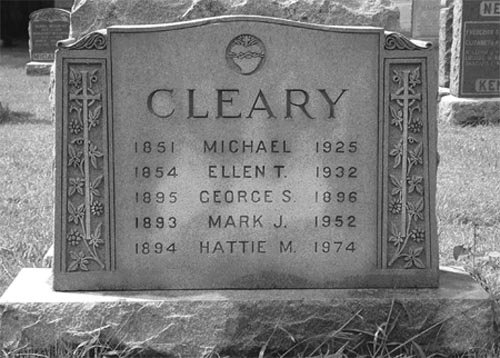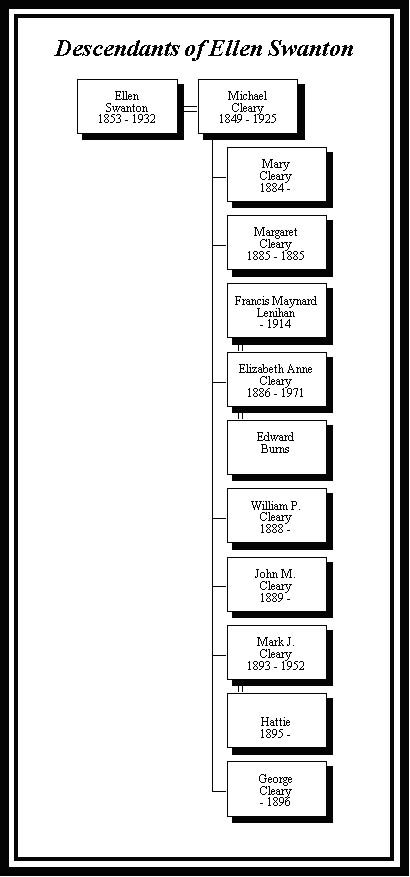

Ellen T. Swanton was the third daughter of Michael and Elizabeth Bradfield Swanton. She was baptized on June 12, 1853 in the Church of the Immaculate Conception in Enniskeane. Her family lived either in Derrigra in the town of Ballineen or in the townland of Boulteen when Ellen was born.
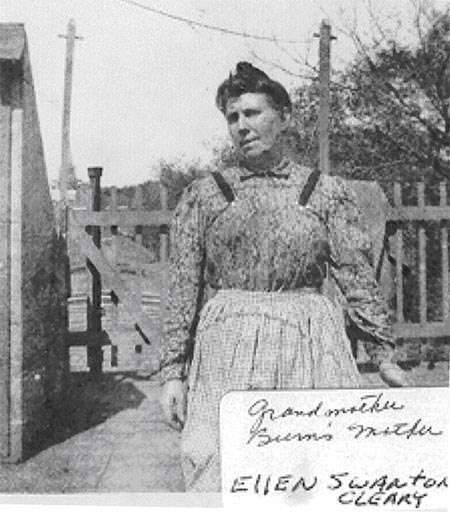
When Ellen was 14 years old, she lived in Boulteen at the Boulteen Cross Roads, where her father did carpentry work and ran a pound. She was confirmed in the Church of the Immaculate Conception in Enniskeane in 1868. Ellen Swanton lived in Ireland until 1882, and she was 29 years old when she left to go to America. Her parents had left for Boston in 1880. Ellen probably stayed in the family home in Boulteen with her brother, Michael and his wife, Jane McCarthy Swanton until 1882. Her sister, Martha, and brother, William, may also have lived with them.
Sometime in 1882, Ellen immigrated to Boston, probably with her sister Martha. Her brother, William, may have gone on ahead to arrange for a place for them to live. I haven’t found a record of their arrival in Boston.
Their brother, William, sailed to New York, and they may have done the same. They would then have taken the train from New York to Boston
There must have been a grand reunion among the Swantons when Ellen and Martha arrived in Boston. They were joining their parents, their younger brothers, Robert and James, their oldest brother, John, his wife, Mary, and John and Mary’s children. Ellen and Martha would be meeting some of their nephews and nieces for the first time.
Once Ellen arrived in Boston, she may have moved in with her brother, John Swanton, who lived at 306 West Second Street in South Boston. However, it was getting pretty crowded in the small apartment at 306 West Second. Twelve people already lived in the Swanton household, probably sharing only one outdoor privy. It’s more likely that Ellen stayed with her brother, William, at his home on South Street in Boston.
Wherever she stayed, it was a fairly short-term arrangement. On September 30, 1884, Ellen Swanton married Michael Cleary, a laborer from Limerick, Ireland. Ellen and Michael were married in the Cathedral of the Holy Cross by Father L. M. Corcoran, a Catholic priest. Their marriage witnesses were Michael Hays and Ellen’s sister, Martha Swanton Crowley.

Michael Cleary was the son of William Cleary and Margaret (Peg) Barrett. Michael was baptized into the Catholic faith on August 29, 1849 in Cullane, Ballylanders, in the county of Limerick in Ireland.
Michael Cleary arrived in New York on June 1, 1874, and became a naturalized citizen of the United States on May 15, 1878. The witnesses to his naturalization were John Spellman and Amos Henebery. He lived in Cambridge, MA between 1875 and 1878.
Michael and Ellen Cleary’s first child was a daughter who was born in July of 1885. They named her Margaret, after Michael’s mother. Margaret’s grandmother, Bessie Bradfield Swanton, had died just a month before Margaret Cleary was born. Margaret died at the age of 4 months, and was buried with her grandmother at Mt. Calvary Cemetery. It must have been very painful for Ellen Swanton Cleary to lose her mother and her first child within such a short period of time.
A year later, on July 19, 1886, Ellen Swanton Cleary gave birth to her second daughter, Elizabeth Anne Cleary. The Cleary family grew rapidly over the next seven years. William Cleary joined the family in August of 1888. He was named after Michael Cleary’s father. William was followed by John Cleary, who was born in September of 1889 and Mark, who was born in June of 1893. In 1895, Ellen and Michael had another son, George, who did not survive. He died on October 15, 1896.
In 1900, the Cleary family lived in Cambridge at 71 Putnam Avenue. Michael worked as a brass moulder.
According to Claire Crowley, the grand-daughter of Ellen's sister, Martha Swanton Crowley, Ellen Swanton Cleary was the matriarch of the Swantons, and she “called the shots”, not only in her family, but also in Martha's familyEllen Swanton Cleary was very typical of the strong, tough, and sometimes unyielding Irish women of the times.

On May 28, 1908, Elizabeth Anne Cleary married Francis Maynard Lenihan. Frank was a pharmacist from Providence, Rhode Island. His parents were Michael Lenihan, who was born in Connecticut, and Catherine Linden, who was born in Ireland. At the time of their marriage, Elizabeth Cleary was also living in Providence, Rhode Island, and was working as a clerk.
Elizabeth Cleary and Frank Lenihan were married in Natick, Massachusetts by James McManus, a Justice of the Peace. Elizabeth was 21 and Frank was 28 when they married. Elizabeth had been raised in a strict Catholic household, so it’s unusual that she would have been married by a Justice of the Peace, rather than in a church by a Catholic priest. Elizabeth was “with child” when she married Frank, and on October 1, 1908, their first daughter, Dorothea Frances Lenihan, was born.
Frank Lenihan died on November 8,1914 of chronic interstitial nephritis at the age of 34. He was buried in St. Paul’s Cemetary in Arlington, Massachusetts.
Mark Cleary married a woman named Hattie (Harriet), and they had two daughters—Ella, who was born in 1914, and Francis, who was born in 1915. Mark, Hattie, Ella and Francis lived just around the corner from Ellen and Michael Cleary, at 7 Flagg Street in Cambridge. Michael and Ellen owned both of the house at 71 Putnam Street and the one at 7 Flagg Street. Their values of these properties in 1925 were $4,450 and $4,550 respectively.
By 1920, all the children had moved out, leaving only Michael and Ellen in the big house at 71 Putnam Avenue. In 1920, Mark Cleary was a policeman on the Cambridge Police Force. John fought in WWI, possibly first in the English Army and then in the American Army. Will was a policeman on the Boston Police Force. In about 1924, Elizabeth Cleary Lenihan, who had been a widow for 10 years, married Edward Burns.
Michael Cleary died on November 6, 1925 in the Cambridge City Hospital at the age of 74. He died of cardio renal disease and a coronary embolism and was buried at St. Paul’s Cemetary in Arlington, MA.
When Michael died, his daughter, Elizabeth A. Burns was living at 116 Hillside Avenue in Cambridge, about 6 miles from her parents’ house. Mark was still living at 7 Flagg Street. John Cleary was living in Chicago, IL, and William was living in Los Angeles, CA.
In Michael Cleary’s will, he left all his real estate to his wife, Ellen Swanton Cleary, for the duration of her life. He specified that after Ellen’s death, the real estate was to go to his daughter, Elizabeth A. Cleary Burns and her heirs. He left $1,000 each to his sons, John and William Cleary, $500 to Dorothy F. Linehan, Elizabeth Cleary Burns’ daughter and $50 to the wife of his brother, William Cleary, in Cullane, Bally Landers, Limerick.
There appears, however, to have been some bad feelings between Michael Cleary and his son Mark. Michael left $10 to Mark, essentially cutting him out of his will. Any money remaining after the legacies and costs of probating the will were to go to Elizabeth A. Cleary Burns.
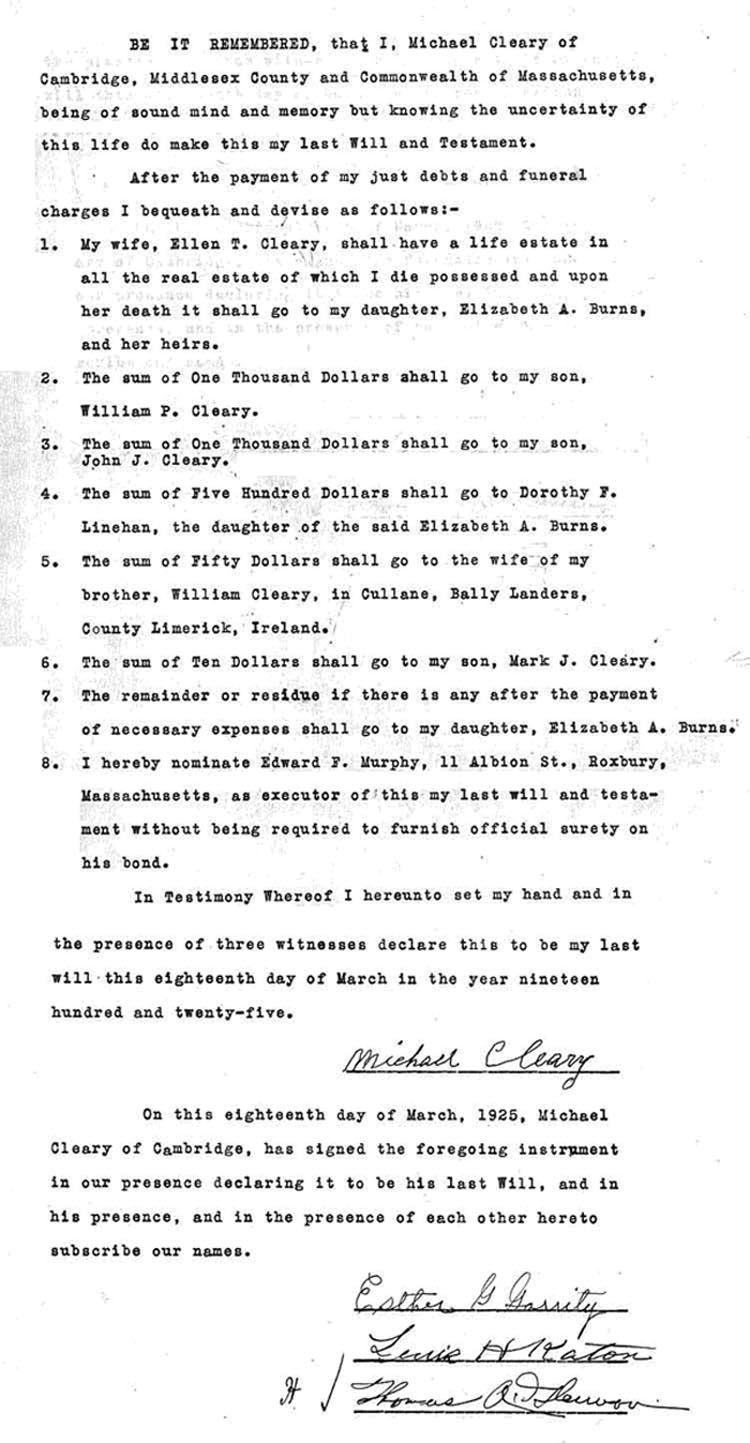
Ellen and Mark Cleary contested Michael Cleary’s will, filing an objection to it on November 25, 1925. Apparently they both felt that Mark had been treated unfairly in it. Unfortunately, the probate documents for Michael Cleary’s will don’t indicate the outcome of Ellen and Mark’s objection to this will.
Ellen Swanton Cleary died on September 25, 1932 of a cerebral hemorrhage, contributed to by organic heart disorder auricular fibrillation. When she died, she was in the Glenside Hospital in Boston, a private institution for the treatment of mental disorders. When Mark initially took his mother there, his sister, Elizabeth, wanted to accompany them, but he refused to take her.
Ellen had made a will in 1920 in which she divided her possessions equally amongst her children. However, on September 17, 1932, just eight days before she died, her son, Mark, visited her at Glenside Hospital. He had a new will with him, and he wanted Ellen to sign it. He had also brought with him three people to witness the signing of this new will. One of the witnesses, Jessie B. Wilson, later testified that upon seeing them, Ellen asked, “What are you all here for? What is all the hurry for?” Nevertheless, Ellen signed the will with her mark, an “X”, in the presence of these witnesses, and after she signed this will, her previous will disappeared, never to be seen again.
The terms of this new will were heavily biased in Mark’s favor—in it, Elizabeth got nothing, John received ¼ of her real and personal property, and Mark got everything else. There was no mention of William, so he may have been dead by then.
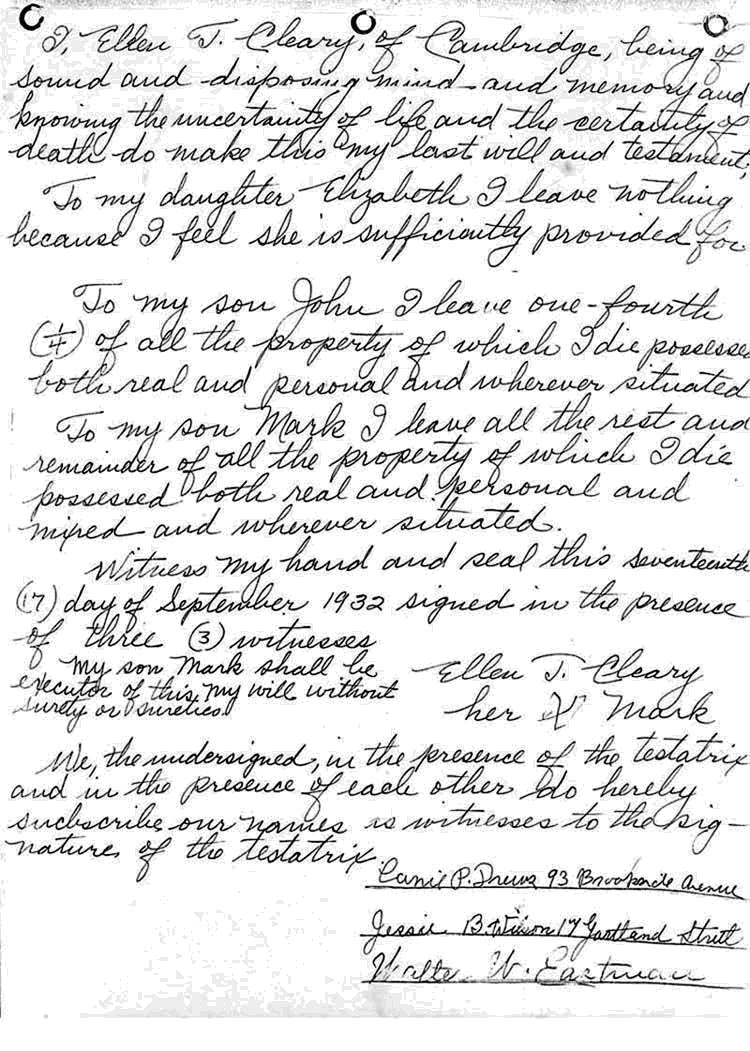
When Ellen Swanton Cleary died, Elizabeth Cleary Burns lived at 18 Haviland Street in Boston, Mark Cleary still lived at 7 Flagg Street, and John Cleary’s residence was given as “parts unknown”.
Mark Cleary had been named as the executor of Ellen’s will, but he declined, and Walter Costello was appointed in his place. The will was filed without probate, as it turned out there was no property real, personal or mixed, to pass under the will. When Walter filed Ellen’s will in the Probate Court, his petition contained some fairly unpleasant allegations.
Walter Costello claimed that when Ellen Swanton Cleary died, she had been of advanced age (81), and for some period prior to her death she had been insane, suffering from violent mental disorders and general physical collapse. He claimed that she was unable to take proper care of herself and her possessions.
Walter Costello also claimed that while Ellen Swanton Cleary was confined in Glenside Hospital, Mark, went to Ellen’s home at 71 Putnam Avenue, broke open Ellen’s strong box, and appropriated its contents, which consisted of $16,000. Walter claimed that Mark then deposited this money into joint accounts in various banks with both his name and his mother’s name on them.
Mr. Costello went on to allege that when these joint accounts were created, Ellen was mentally incapacitated, and did not have the mental capacity to assent to the creation of these accounts. He also claimed that Ellen had retained sole control of the contents of the strong box during her lifetime.
He requested that Mark Cleary be ordered by law to turn over this money to the court, pending further investigation.
When these funds were frozen, Mark tried to access another joint bank account that he had opened in 1930. He claimed that it had been created for his benefit, and was not part of Ellen’s estate. He had deposited $1,000 into this account when he opened it, and it had accumulated interest since then.
After further investigation, Walter Costello filed his Findings of Facts, a carefully worded document outlining 25 points. These findings speak for themselves:
REQUESTS FOR FINDINGS OF FACTS BY THE COMPLAINANT WALTER F. COSTELLO ADM.
Following is Mark’s response to these findings:
ANSWER OF RESPONDENT
MARK J. CLEARY
By his Attorneys
Kerwin & Boyle
W. M. Kerwin
A motion was made for the case to go to a jury trial, but it doesn’t appear that a trial ever took place. The final account of Ellen Swanton Cleary’s estate was filed on January 2, 1934, and it stated that the value of her estate was “Nothing.”
This is the last document that appears in the probate file for Ellen’s will. No mention was made of the disposition of the houses at 71 Putnam Avenue and 7 Flagg Avenue. I wonder if Mark ended up dividing the proceeds of those joint bank accounts with his sister, as he had claimed he wanted to do, and if his brother, John, received anything. We may never know.
I don’t know if Mark was innocent or guilty, but I have to admit the evidence against him is very convincing. There’s a touch of irony, though, in that throughout this litigation, Mark was still working as a policeman on the Cambridge Police Force.
Mark Cleary died in 1952, and his wife, Hattie, died in 1974. They are buried with Mark’s parents, Ellen and Michael, and Mark’s brother, George, in St. Paul’s Cemetary, Arlington.
